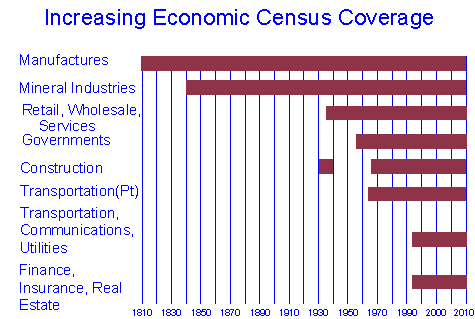Guide to the
2002 Economic Census
The economic census has been taken as an integrated program at 5-year intervals since 1967 and before that for 1954, 1958, and 1963. Prior to that time, individual components of the economic census were taken separately at varying intervals.
The economic census traces its beginnings to the 1810 Decennial Census, when questions on manufacturing were included with those for population. Coverage of economic activities was expanded for the 1840 Decennial Census and subsequent censuses to include mining and some commercial activities. The 1905 Manufactures Census was the first time a census was taken apart from the regular decennial population census. Censuses covering retail and wholesale trade and construction industries were added in 1930, as were some covering service trades in 1933. Censuses of construction, manufacturing, and the other business service censuses were suspended during World War II.
The 1954 Economic Census was the first census to be fully integrated: providing comparable census data across economic sectors, using consistent time periods, concepts, definitions, classifications, and reporting units. It was the first census to be taken by mail, using lists of firms provided by the administrative records of other Federal agencies. Since 1963, administrative records also have been used to provide basic statistics for very small firms, reducing or eliminating the need to send them census questionnaires.

The range of industries covered in the economic censuses expanded substantially between 1967 and 1992. The census of construction industries began on a regular basis in 1967, and the scope of service industries, introduced in 1933, was broadened in 1967, 1977, and 1987. While a few transportation industries were covered as early as 1963, it was not until 1992 that the census broadened to include all of transportation, communications, and utilities. Also new for 1992 was coverage of financial, insurance, and real estate industries.
In 2002, census coverage added landscape architecture, landscaping services, veterinary services, and pet care, industries previously classified as agricultural services. With these additions, the economic census and the separate census of governments collectively cover roughly 96 percent of all economic activity. (There is also a census of agriculture, now collected by the U.S. Department of Agriculture, covering another 2 percent of economic activity.)
For a much more detailed examination of the historical development of the Economic Census, see Appendix B in the History of the Economic Census.
Historical Statistics
Because of the change from SIC to NAICS in 1997, Comparative Statistics (classified by SIC) is the only 1997 Economic Census report completely compatible with prior census data. CD-ROMs issued from the 1987 and 1992 Economic Censuses contain databases for nearly all data published from those two censuses, plus a few additional files covering selected sectors for 1982 and 1977.
Statistical reports from the 1992 census are most readily available as pdfs at this website, but there are no pdfs for earlier census data. Printed reports from earlier censuses, providing historical figures for the study of long-term time series, are available for reference at many major libraries, or can be purchased in photocopy form from the Census Bureau.


 Back to How the data are collected
Back to How the data are collected